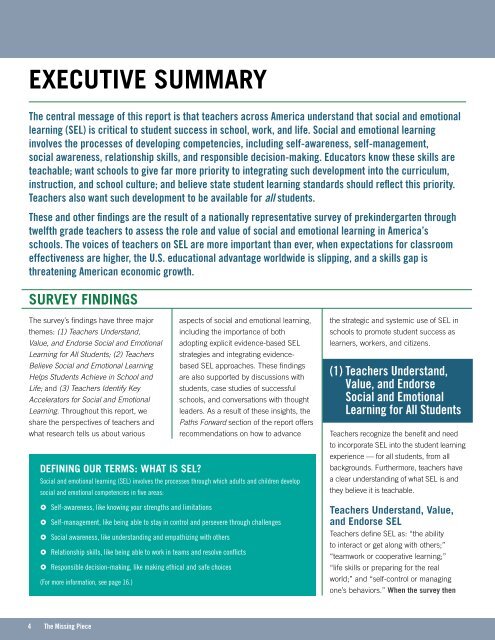the-missing-piece
the-missing-piece
the-missing-piece
Create successful ePaper yourself
Turn your PDF publications into a flip-book with our unique Google optimized e-Paper software.
EXECUTIVE SUMMARYThe central message of this report is that teachers across America understand that social and emotionallearning (SEL) is critical to student success in school, work, and life. Social and emotional learninginvolves <strong>the</strong> processes of developing competencies, including self-awareness, self-management,social awareness, relationship skills, and responsible decision-making. Educators know <strong>the</strong>se skills areteachable; want schools to give far more priority to integrating such development into <strong>the</strong> curriculum,instruction, and school culture; and believe state student learning standards should reflect this priority.Teachers also want such development to be available for all students.These and o<strong>the</strong>r findings are <strong>the</strong> result of a nationally representative survey of prekindergarten throughtwelfth grade teachers to assess <strong>the</strong> role and value of social and emotional learning in America’sschools. The voices of teachers on SEL are more important than ever, when expectations for classroomeffectiveness are higher, <strong>the</strong> U.S. educational advantage worldwide is slipping, and a skills gap isthreatening American economic growth.SURVEY FINDINGSThe survey’s findings have three major aspects of social and emotional learning,<strong>the</strong>mes: (1) Teachers Understand,including <strong>the</strong> importance of bothValue, and Endorse Social and Emotional adopting explicit evidence-based SELLearning for All Students; (2) Teachers strategies and integrating evidencebasedSEL approaches. These findingsBelieve Social and Emotional LearningHelps Students Achieve in School and are also supported by discussions withLife; and (3) Teachers Identify Keystudents, case studies of successfulAccelerators for Social and Emotional schools, and conversations with thoughtLearning. Throughout this report, we leaders. As a result of <strong>the</strong>se insights, <strong>the</strong>share <strong>the</strong> perspectives of teachers and Paths Forward section of <strong>the</strong> report offerswhat research tells us about various recommendations on how to advanceDEFINING OUR TERMS: WHAT IS SEL?Social and emotional learning (SEL) involves <strong>the</strong> processes through which adults and children developsocial and emotional competencies in five areas: Self-awareness, like knowing your strengths and limitations Self-management, like being able to stay in control and persevere through challenges Social awareness, like understanding and empathizing with o<strong>the</strong>rs Relationship skills, like being able to work in teams and resolve conflicts Responsible decision-making, like making ethical and safe choices(For more information, see page 16.)<strong>the</strong> strategic and systemic use of SEL inschools to promote student success aslearners, workers, and citizens.(1) Teachers Understand,Value, and EndorseSocial and EmotionalLearning for All StudentsTeachers recognize <strong>the</strong> benefit and needto incorporate SEL into <strong>the</strong> student learningexperience — for all students, from allbackgrounds. Fur<strong>the</strong>rmore, teachers havea clear understanding of what SEL is and<strong>the</strong>y believe it is teachable.Teachers Understand, Value,and Endorse SELTeachers define SEL as: “<strong>the</strong> abilityto interact or get along with o<strong>the</strong>rs;”“teamwork or cooperative learning;”“life skills or preparing for <strong>the</strong> realworld;” and “self-control or managingone’s behaviors.” When <strong>the</strong> survey <strong>the</strong>n4 The Missing Piece


